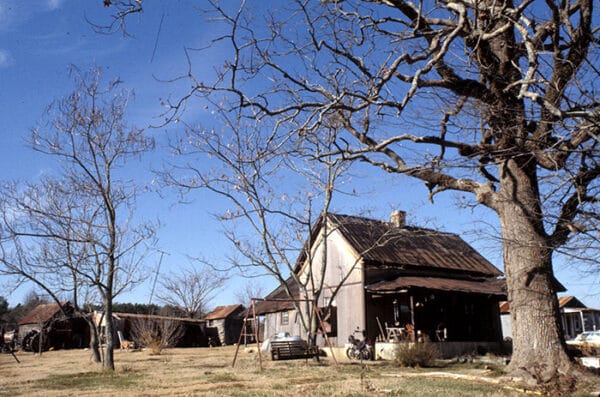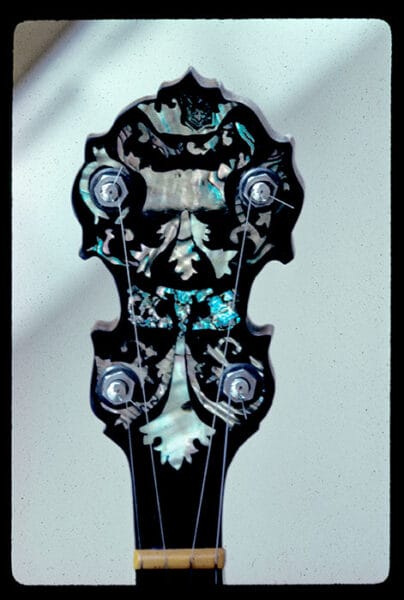Arlin Moon
 Arlin Moon
Cullman County native Arlin Moon (1917-2008) was a nationally known and celebrated stringed instrument maker, musician, and music promoter. Born in Holly Pond, Cullman County, on March 12, 1917, to Willie S. Moon and Eula Barnett Moon, Arlin grew up in a musical family. Both his parents and several uncles played fiddle, banjo, and piano. As a young man, Moon worked in his uncle’s wood-working shop making chairs, baseball bats, and farm wagons. As he honed his wood-working skills, he began making musical instruments, including fiddles, guitars, mandolins, and banjos. His early banjos consisted of hickory wood frames and heads of stretched opossum hide from animals he caught himself. In later years, he made frames from beechwood, cherry, mulberry, dogwood, persimmon, and walnut and switched to synthetic heads. He was married to Margie Inez Sizemore, with whom he had four children.
Arlin Moon
Cullman County native Arlin Moon (1917-2008) was a nationally known and celebrated stringed instrument maker, musician, and music promoter. Born in Holly Pond, Cullman County, on March 12, 1917, to Willie S. Moon and Eula Barnett Moon, Arlin grew up in a musical family. Both his parents and several uncles played fiddle, banjo, and piano. As a young man, Moon worked in his uncle’s wood-working shop making chairs, baseball bats, and farm wagons. As he honed his wood-working skills, he began making musical instruments, including fiddles, guitars, mandolins, and banjos. His early banjos consisted of hickory wood frames and heads of stretched opossum hide from animals he caught himself. In later years, he made frames from beechwood, cherry, mulberry, dogwood, persimmon, and walnut and switched to synthetic heads. He was married to Margie Inez Sizemore, with whom he had four children.
 Arlin Moon Homestead, 1985
Beginning in the 1940s, Moon stopped making musical instruments and turned his attention to raising and supporting his family with farming and his one-chair rural barber shop. In the 1960s, he again took up instrument making. He also formed a family string band, The Home Folks, and turned his old barn into a performance venue, The Red Barn. There, he presented weekend concerts and barn dances featuring local and regional musicians. Some nationally recognized musicians, including Bill Monroe, Carl Story, and the Sullivan Family, also performed at The Red Barn.
Arlin Moon Homestead, 1985
Beginning in the 1940s, Moon stopped making musical instruments and turned his attention to raising and supporting his family with farming and his one-chair rural barber shop. In the 1960s, he again took up instrument making. He also formed a family string band, The Home Folks, and turned his old barn into a performance venue, The Red Barn. There, he presented weekend concerts and barn dances featuring local and regional musicians. Some nationally recognized musicians, including Bill Monroe, Carl Story, and the Sullivan Family, also performed at The Red Barn.
By the 1980s, Moon had achieved regional and national recognition for his vast traditional fiddle tune repertoire and for his hand-crafted musical instruments. Folklorists and musicologists from across the country travelled to his Holly Pond farm to interview Moon and document his musical repertoire. Craft historians, collectors, and curators visited his workshop and viewed his handcrafted instruments. He also was the subject of several television documentaries.
 Banjo Headstock
In 1985, Moon was named a master folk artist by the Alabama State Council on the Arts and for three years participated in the Alabama Folk Arts Apprenticeship Program, teaching daughter Betty the art of instrument making and granddaughter Tina his fiddle repertoire.
Banjo Headstock
In 1985, Moon was named a master folk artist by the Alabama State Council on the Arts and for three years participated in the Alabama Folk Arts Apprenticeship Program, teaching daughter Betty the art of instrument making and granddaughter Tina his fiddle repertoire.
Over the years, Moon’s instruments have been displayed in special exhibitions at numerous Alabama museums and galleries, including the Birmingham Museum of Art and the Alabama Artists Gallery in Montgomery. In 1980, one of Moon’s hand-crafted banjos was selected as the sole representative piece of Alabama folk craftwork to be displayed at the national offices of what is now the Family, Career, and Community Leaders of America headquartered Reston, Virginia.
Moon died March 8, 2008, and is buried in Holly Pond Cemetery in Holly Pond. His musical legacy continues through his daughter, Betty Moon Sampson, of Holly Pond, and his granddaughter, Tina Ray Miller, of Arab. Both are regionally recognized musicians and vocalists and featured performers on the Sisters of the South tour organized by Atlanta’s Southern Arts Federation in the 1990s.
Additional Resources
Cauthen, Joyce H. With Fiddle and Well-Rosined Bow: A History of Old Time Fiddling in Alabama. Tuscaloosa: University of Alabama Press, 2001.
Kimzey, Anne, ed. Carry On: Celebrating Twenty Years of the Alabama Folk Arts Apprenticeship Program. Montgomery: Alabama Center for Traditional Culture, 2008.
Martin, Stephen H., ed. Alabama Folklife: Collected Essays. Birmingham: Alabama Folklife Association, 1989.
Traditional Music of Alabama. 5 vols. Montgomery: Alabama Center for Traditional Culture, 2001-2006.



